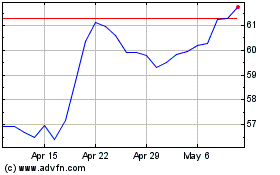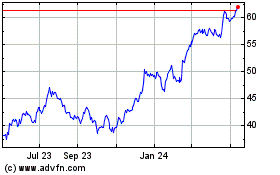Wells Fargo's Results Sink on Legal Reserves -- 3rd Update
January 14 2020 - 11:59AM
Dow Jones News
By Ben Eisen
Wells Fargo & Co.'s fourth-quarter profit plunged, hurt by
costs related to its long-running fake-account scandal and flagging
business lines.
The lender on Tuesday said it took a $1.5 billion charge for
costs stemming from the scandal that has dogged it since 2016,
fueling a 53% profit drop. The bank has said it is in talks to
settle a joint Justice Department and Securities and Exchange
Commission investigation into the matter.
The quarter also marked the start of the tenure of Charles
Scharf, who joined Wells Fargo as chief executive in October. He
has been tasked with resolving a pile of regulatory issues and
improving the San Francisco-based bank's reputation.
In a statement, Mr. Scharf called the bank "a wonderful and
important franchise that has made some serious mistakes." He said
he would make fundamental changes to regain trust and would tackle
regulatory problems "with a different sense of urgency and
resolve."
The bank's quarterly earnings totaled $2.87 billion, versus
$6.06 billion a year earlier. Per-share earnings of 60 cents missed
the $1.12 expected by analysts polled by FactSet.
Wells Fargo shares fell 4% in morning trading.
Underneath the regulatory problems, Wells Fargo's business lines
have also been struggling.
Fourth-quarter revenue fell 5%, to $19.86 billion from $21
billion a year earlier. Analysts had expected $20.1 billion.
Revenue declines have forced the bank to refocus on cutting
costs, and Mr. Scharf said Tuesday that the cost structure was
still too high. The bank's expenses rose 17% to $15.6 billion from
$13.3 billion a year ago. Reflecting the cost of litigation, the
bank's full-year expenses of $58.2 billion missed the company's
target of about $53 billion.
Wells Fargo shares rose 17% in 2019, lagging behind its peers
and the broader S&P 500. Shares were already down slightly to
start 2020 before Tuesday's decline.
The Federal Reserve cut interest rates three times last year,
adding pressure on the banking sector by crimping what banks can
charge on loans.
Net interest income fell 11% from $12.6 billion in the year-ago
quarter. Net interest margin, which measures the difference between
what banks charge to lend and what they pay to borrow, dropped to
2.53% from 2.66% in the third quarter.
Despite falling rates, Wells Fargo paid more for its deposits.
The yield on total interest-bearing deposits was 0.85% in the
fourth quarter, versus 0.77% a year earlier.
Noninterest income, which is more protected from rate
fluctuations, rose 4%.
Mortgage lending, a key area for Wells Fargo, picked up.
The bank was the largest mortgage lender by originations in the
third quarter, according to industry research group Inside Mortgage
Finance. It extended $60 billion in the fourth quarter as
homeowners continued to refinance, versus $38 billion a year
earlier.
Still, revenue was down from a year earlier in the consumer
banking and wholesale banking business lines. The wealth-management
division's revenues rose 3%, driven by stock market gains and
higher advisory fees.
-- To receive our Markets newsletter every morning in your
inbox, click here.
Write to Ben Eisen at ben.eisen@wsj.com
(END) Dow Jones Newswires
January 14, 2020 11:44 ET (16:44 GMT)
Copyright (c) 2020 Dow Jones & Company, Inc.
Wells Fargo (NYSE:WFC)
Historical Stock Chart
From Mar 2024 to Apr 2024

Wells Fargo (NYSE:WFC)
Historical Stock Chart
From Apr 2023 to Apr 2024
